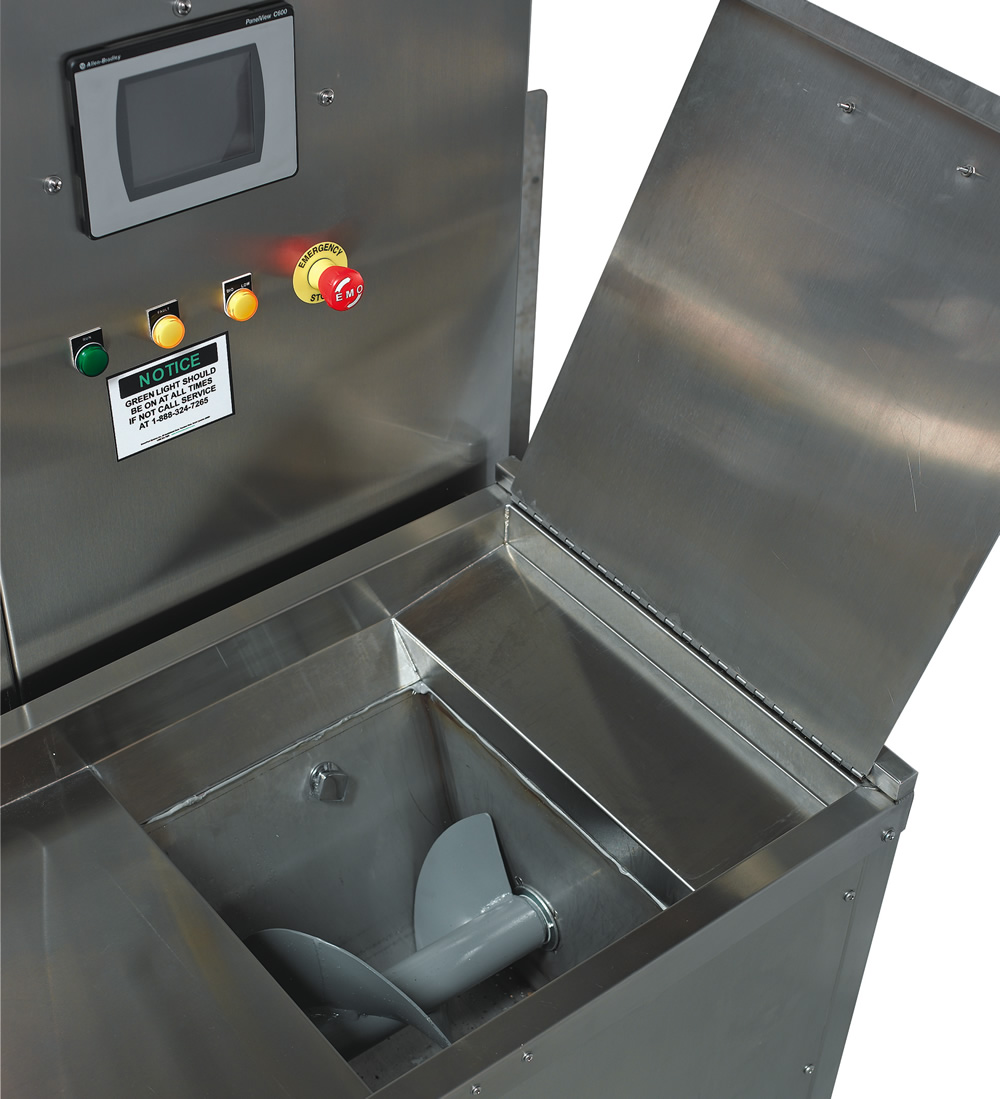Pending organics disposal bans and/or commitments to divert food waste from landfills has led to fairly aggressive marketing by vendors of on-site food waste processing systems. Part I
Zoë Neale
BioCycle October 2013, Vol. 54, No. 10, p. 20
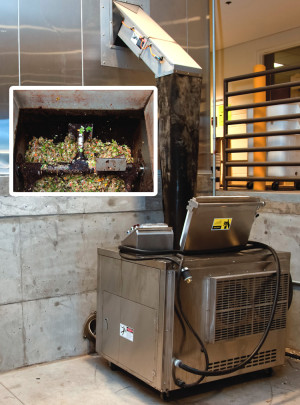
Food waste is pulped and dewatered (example inset) prior to dehydration by thermal means. Units can include pulping or be paired with stand-alone equipment. A Somat dehydrator is shown. Photos courtesy of Lin Sensenig, Somat
As SSO generators and facility managers attempt to obtain information about on-site systems independent of the sales calls and marketing claims, they can encounter difficulty finding objective comparative studies that discuss the range of available options applicable to their site-specific considerations. The goal of this two-part article series is to provide an objective analysis for institutional, commercial and industrial (ICI) generators of food waste. Part 1 describes and discusses two categories of on-site processing technologies for the ICI sector: biodigesters (otherwise known as “wet” systems) and dehydrators (“dry” systems). Part 2 includes case studies of users of various on-site systems. Not all commercially available on-site systems in these two categories are included in Parts I and II.
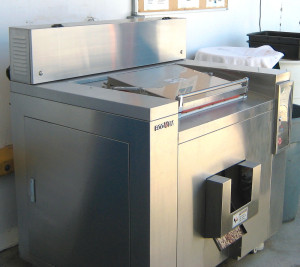
The EcoVim 250 dehydrator installed at the La Quinta Resort & Spa processes 250 lbs/day of food waste, yielding 25 lbs of processed organics. Photo courtesy on Onsite Waste Solutions
Throughout the process of conducting research for this article, one of the most challenging aspects was to identify and successfully contact distributors and vendors of the various technologies. Of the approximately nine biodigester companies contacted, only half returned calls despite repeated attempts. This narrowed the universe of companies profiled. Also precluded from the research set were companies that did not have contact information in the U.S. and/or lacked reference facilities in the U.S. In the dehydration marketplace, we found that changes in distribution agreements are quite common, leading to confusion as to who is selling what, what party is responsible for maintenance, and difficulty reconciling differing product claims. Unfortunately this ever-changing landscape makes it very difficult for potential customers to conduct independent due diligence. Confirmation of product promises is complicated by the fact that many of these systems are distributed by resellers, equipment leasing companies and waste consultants (separate from direct distribution), who often change the system that they sell/lease for a myriad of reasons. This distribution opacity has created confusion and uncertainty in the marketplace.
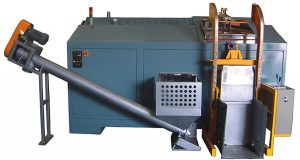
The Gaia dehydrator has an 8 to 11 hour processing cycle and can be equipped with a tote lifter to empty food waste into the machine. Photo courtesy of Gaia
Basic Descriptions
Dehydrators and biodigesters employ varying levels and different types of technology. Dehydrators use a mechanical/thermal approach that effectively separates liquids from the solids. Dehydration systems can include pulping within the dehydrator itself, or can be coupled with stand-alone pulping and dewatering units to achieve maximum volume and weight reduction. With both approaches, the liquid portion is disposed of through the sewer and the greatly reduced solid portion is disposed of or diverted for recycling. At locations with higher volumes such as college cafeterias, preprocessing separately and then dehydrating in the unit is recommended for best results. The three companies most established in selling dehydrators are Somat, EcoVim and Gaia although other machines are available. There are also hybrid systems available such as the BioGreen. This system combines elements of biodigesters with dehydrators resulting in a pelletized organic residual by-product. Overall, composters interviewed who receive the output from dehydrators expressed satisfaction with this feedstock as it contains valuable nitrogen and carbon.
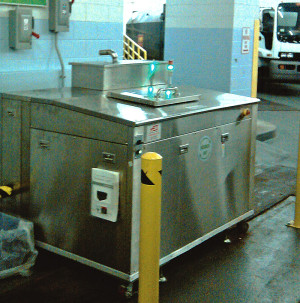
BioGreen’s hybrid system (shown at an installation in Boston) combines elements of biodigesters and dehydrators, resulting in a pelletized organic residual by-product. Photo courtesy of BioGreen
Many of these machines originated in South Korea and have been licensed to various entities to sell in the U.S. The key differentiators between biodigesters on the market are the composition of the biologic agent added to the waste to accelerate the decomposition process, and how effectively and efficiently the systems process and convert the waste to liquid. Water usage by these units range from 1 gallon/4 lbs of food on the low end to 1 gallon/1 lb on the high end.
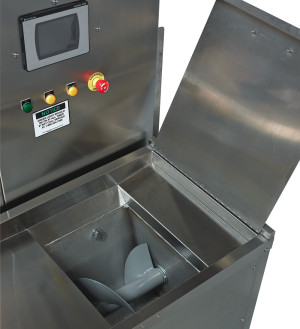
The food chute is pictured on EnviroPure’s biodigester. Units range in capacity — from 120 to 3,000 lbs/24-hour period. Photo courtesy of EnviroPure
Sewer Considerations
Due to the relatively small installed base of biodigesters and dehydrators in the U.S., most wastewater and plumbing permitting authorities have not revised guidelines or regulations that would apply to installation of these systems. After interviewing multiple wastewater authorities at municipal and district levels, regulatory officials have either limited knowledge of these systems or, at best, a very generalized understanding of what they do and how they do it. Biodigester companies are generally encountering little permitting resistance when installing their systems as they often characterize the install as ”replacing an existing fixture“ such as a slop sink, which requires no permitting. As such, vendors often do not proactively contact the local wastewater agency regarding acceptable discharge levels for BOD, FOG (fats, oils, grease) and total solids levels unless requested to do so by the customer.
Permitting authorities are cognizant of potential wastewater system issues that may stem from traditional garbage grinding or macerating of food waste prior to direct disposal into a treatment plant’s sanitary sewer system, e.g., potential to cause “slugs,” otherwise known as clogs. As such, many municipalities explicitly prohibit this grinding with direct disposal. As authorities become more aware of the potential for problematic new effluent discharges into their sewer systems, a serious concern arises regarding potential damage to the plumbing systems over time. Wastewater from industries that generate large amounts of food waste tend to carry high levels of chemical and biological pollutants, especially BOD. When mixed in a sanitary sewer system with sulfates, normally present in the human digestive track, hydrogen sulfide (H2S), can be formed. H2S is a corrosive and acidic gas that can corrode pipes — not a desirable outcome for those responsible for maintaining plumbing and wastewater systems. Municipalities and districts with smaller wastewater treatment facilities and/or older buildings with narrower drains are particularly vulnerable to these effects due to smaller volumes and pipe sizes.
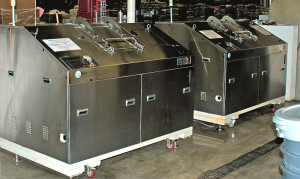
BioHitech America utilizes microbes and enzymes to break down food waste in its biodigesters (two units shown side-by-side at a food bank installation in New Jersey). Photo courtesy of BioHitech
Reconciling Product Claims With Reality
Waste To Water: The scope of research for this article included interviewing vendors, users, consultants and wastewater officials. Throughout this process, the most challenging aspect has been substantiation of the vendors’ marketing claims. (In addition, a number of companies, especially in the biodigester market, appear to be actively marketing systems but are not accessible via telephone or email.) Biodigester vendors use the claim, “waste to water.” All of the biodigester systems included in this study claim significant BOD and total suspended solids (TSS) reduction although this claim is clearly the most difficult to independently confirm because: 1) Levels vary depending on the type of initial waste fed into the machine (some organics such as dough and dairy have inherently higher BOD levels); 2) Levels are dependent on ”seed count” of the microorganisms (the amount of bacteria present at any given time); and 3) Very few independent studies of effluent characterization are publicly available. Table 3 provides an example of a vendor’s effluent claims. Bear in mind that substantial amounts of water are added to a substrate (organic waste) that already has a liquid content of approximately 85 percent water.
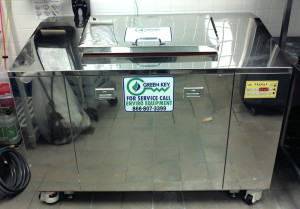
Green Key’s literature notes that water effluent from its biodigester (unit shown installed at a university dining hall) can be “treated and collected for grey water” uses. Photo courtesy of Green Key
Costs Vs. Benefits
As with any additional piece of equipment in most commercial and institutional kitchen settings, space considerations are always a significant hurdle to overcome. Also, depending on which machine and/or technology a generator is considering (biodigesters and dehydration systems alike), access to a drain and/or plumbing (hot and cold or just cold) are considerations. The relatively high amount of water required for biodigesters is cited by users as both cost and sustainability considerations. A key benefit cited by vendors of dehydration systems is that they effectively split the waste into its two basic components, solids and liquids, and process them separately. As an example, a typical dehydrator will convert 250 pounds of food waste into 25 pounds of sterile organic biomass and 25 gallons of water.

Inset photo of the Power Knot illustrates the types of food waste that the unit (installed adjacent to the range) can process. Photos courtesy of Power Knot
When comparing dehydrators and biodigesters, the significant differences are what goes in and what comes out. Dehydrators typically do not require added water as they vaporize the liquid via high temperature, providing the generator with an organic residual that typically shows an 85 to 95 percent reduction in volume and weight. This residual, though, still requires off-site transport, which represents a discreet cost. Biodigesters, on the other hand, work by adding water to biochemically slurried waste and getting rid of it via the sewer. Although hauling is avoided with biodigesters, vendors charge for their proprietary biological additives, which are added at intervals ranging from continuously to once every three to four months. Another cost component for these systems is the required regular replacement of the media added to the vessels (wood or plastic chips) that essentially serve as a habitat for the microorganisms.
One of the key sustainability benefits of dehydrators vs. biodigesters is that a much larger fraction of nutrient value in the organics is retained. The water that is disposed (condensate) by dehydration systems does contain BODs although these levels have not been flagged as a major concern. Effluent from biodigesters, on the other hand, is raising red flags in the wastewater community because if the liquid that is being discharged into the wastewater treatment system does, in fact, carry high levels of BOD and sludge, then the cost of the disposal is essentially being transferred from the generator to the municipal ratepayers.
On-site organic waste solutions for larger organics generators are appealing on economic, logistical and hygienic levels, but the promise of a proverbial “silver bullet“ solution to dealing with large amounts of organics simply does not exist. Indeed, with every system reviewed and researched there are tangible benefits although none are without costs and opaque product claims. Ultimately, what is clear is that as a result of the light regulatory environment governing dehydration and biodigestion systems coupled with their relatively new appearance on the market, the customer bears the responsibility to verify and validate vendor claims. As one individual who has had experience with these systems said…buyer be aware!
Zoë Neale has spent the bulk of her career as an equity mutual fund manager and advocate for socially responsible investment. She currently works as a business consultant and is a founder and director of Save That Stuff Organics, an organics solutions affiliate of Save That Stuff Inc. Zoë is Treasurer of MassRecycle and chairs the Organics Committee for that organization.


